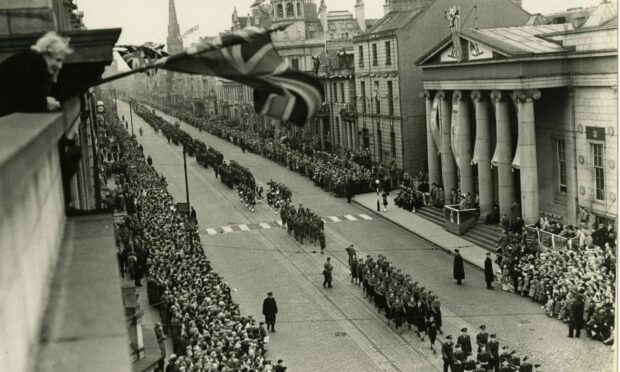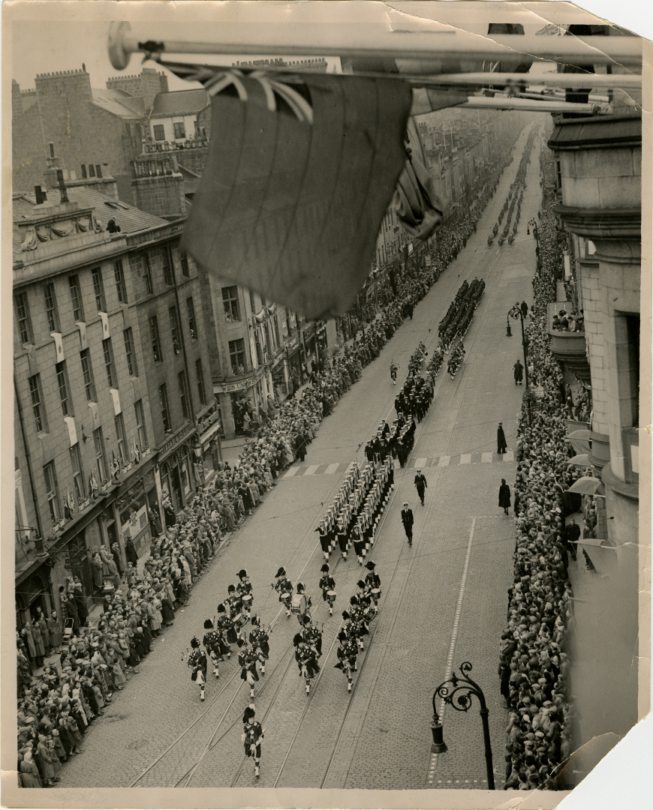Aberdonians stood steadfast in the face of bitter cold and scurrying rain showers to put on a triumphant display for the Queen’s coronation in 1953.
It’s hard to imagine now, but it was estimated that 100,000 people lined the route of the coronation procession through Aberdeen on a cold summer’s day in June.
Standing defiant in drizzle, the crowds stood as cold and grey as the granite of Union Street behind them.
But even the weather couldn’t dampen the coronation spirit that emerged in the city’s joyful parades, colourful processions, fancy dress displays and picnics.
There was such a sense of occasion, it was reported rather prophetically that “the crowning of Queen Elizabeth II at Westminster Abbey was greeted with a fervour in Aberdeen that we are unlikely ever to see again for a royal occasion”.
Opinion has certainly turned on the monarchy ahead of King Charles III’s coronation on May 6, but in 1953, Aberdeen had a right royal knees-up.

Coronation preparation
Aberdonians spent weeks and months fundraising for the city’s week of jubilant coronation activities, packed with entertainment and fun.
It was the first collective celebration since VE Day and an occasion to look forward when there was still rationing.
Communities and organisations came together to spruce up the city in the run-up to Aberdeen’s pageantry.
Heraldic shields above Marischal College’s archway were painted in bright colours as part of the college’s decorations.
Meanwhile, shopkeepers and householders decked out their premises in red, white and blue.
Residents in Chestnut Row received special permission to close their street for a tea party – and one thrifty householder even turned the tenement landing curtains into bunting to deck the street.
A Beechgrove Terrace resident featured in the Evening Express used Christmas lights to illuminate portraits of the Queen and Duke of Edinburgh in their front window.
And Aberdeen’s coronation tree-planting scheme took place in Garthdee and Northfield, with trees planted by Lord Provost Graham and his wife.
But not everyone was keen to celebrate; some Peterhead shopkeepers found their coronation displays had been plastered with “anti-E II R warnings”.
And there was condemnation of another kind – many Royal coats of arms going up across the north-east were the English style and not the Scottish style.
And households were reminded to check their flags after a few Union Jacks were spotted hanging upside down too.
A blaze of colour on Union Street
The coronation day began with a service at West Kirk of St Nicholas where a full-capacity congregation of 1500 packed into the church.
And later, the grey curtain of cloud hanging over Aberdeen on the day of the coronation gave way to the cavalcades of colour sweeping along Union Street and King Street.
The Evening Express (EE) reported how pavements “were blocked eight to ten deep with sightseers and the route of the procession must have been lined by more than 100,000”.
Union Street was a blaze of colour; “a magnificent corridor of scarlet and gold, royal purple, and red, white and blue mingled with the crown and crests of our nation”.
Seventy-four floats and decorated vehicles rolled up the Granite Mile featuring exhibits and tableaux.
Aberdeen Journals’ float carried a glittering replica of the crown jewels, while British Railways’ float raised a few giggles in the crowd.
Its theme was “sunbathing on sands” featuring a group of ‘sunbathers’ shivering in the bitterly cold breeze, as the spectators watched on wearing their winter coats.
Parade stretched as far as the eye could see
The booming drums and pipes of the City of Aberdeen Police Band resounded, followed by more pipe bands, civic, academic and other public leaders, military forces and youth organisations, with the parade giving a salute at the Music Hall.
So long was the procession that it had to mark time at Broad Street while contingents in front were turning into King Street.
And the British Alsatian Association received special cheers from the crowd – for its dogs, who were among the most orderly marchers in the procession.
The EE said: “As far as the eye could see from Castle Street up King Street the pavements were a mass of laughing, cheering folk who stamped their feet to keep warm and knelt on their coats when they were tired.”
A historic occasion for television too
Those who wanted to witness the historic occasion as it happened sat by their wireless sets to listen to proceedings as they unfolded in London.
These were the days before television was widespread, so Craigiebuckler Church made the headlines for their televised showing.
The church screened the coronation and 160 people crowded around three television sets to watch.
It was the first time an event had been broadcast live on television.
Concerns had previously been raised that the TV reception might be too poor so far from London to enjoy the celebrations.
In the days leading up to the Coronation there was “a considerable exodus” of people from Aberdeen to stay with relatives down in Glasgow where it was thought the TV reception would be better.
Those not watching the ceremony on TV would at least have heard Aberdeen’s 21-gun salute, which was given at the moment of the Queen’s crowning.
Four 25-pound guns fired at 20 second intervals on the terrace of Castlehill Barracks, their crashing bangs echoing across the city.
A special day in more ways than one
It was said Aberdeen’s oldest citizen Isabella Diack, aged 102, “added another historic chapter to her long life”.
Isabella listened to the entire coronation broadcast at her home at 390 North Anderson Drive – although she did have a few naps in-between.
And from the city’s oldest citizen, to its youngest – the coronation Day in 1953 was extra special for the Aberdeen babies born on that day.
At Aberdeen Maternity Hospital at 8am, the city’s first coronation baby was born – a little girl called Maureen Elizabeth.
There was no coronation holiday for the midwives though – as another seven babies were born before noon alone at various maternity homes in the city.
But it would certainly have been a memorable day for their mothers.












Conversation